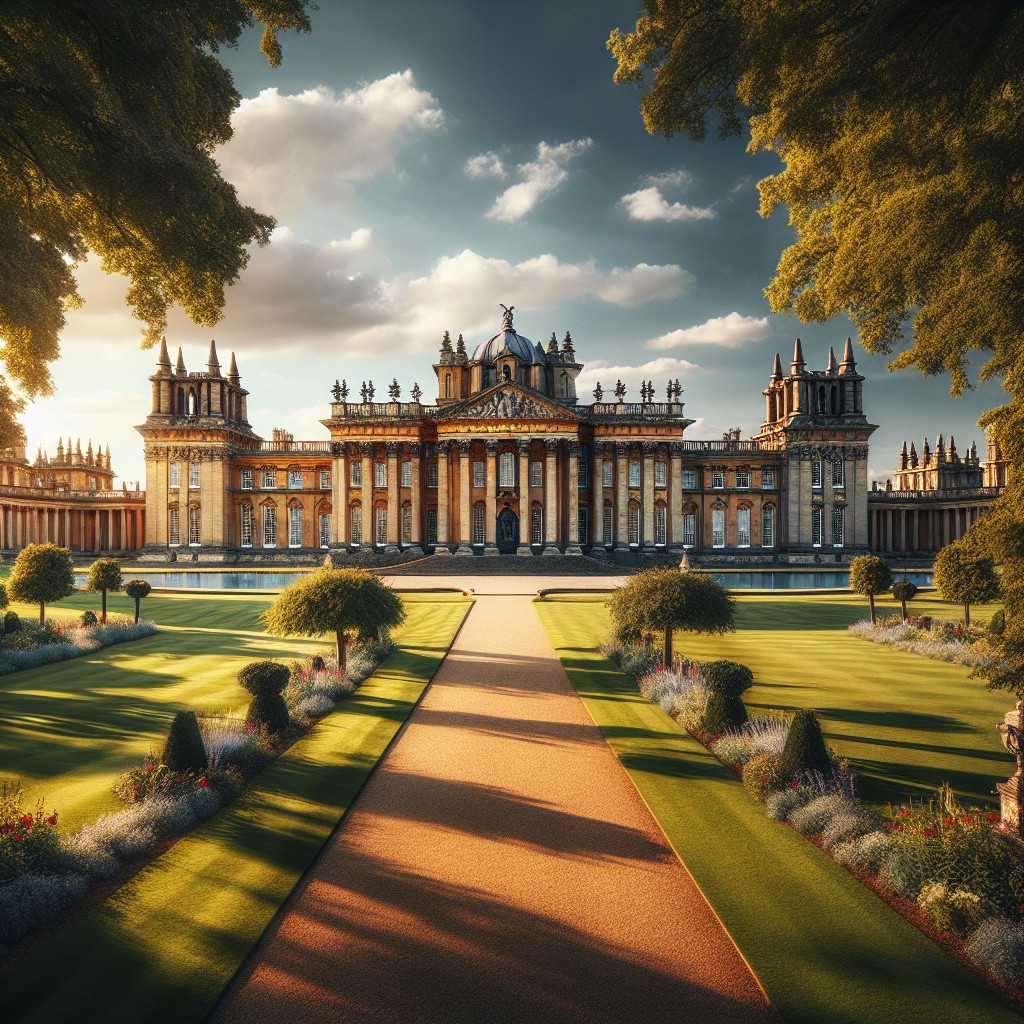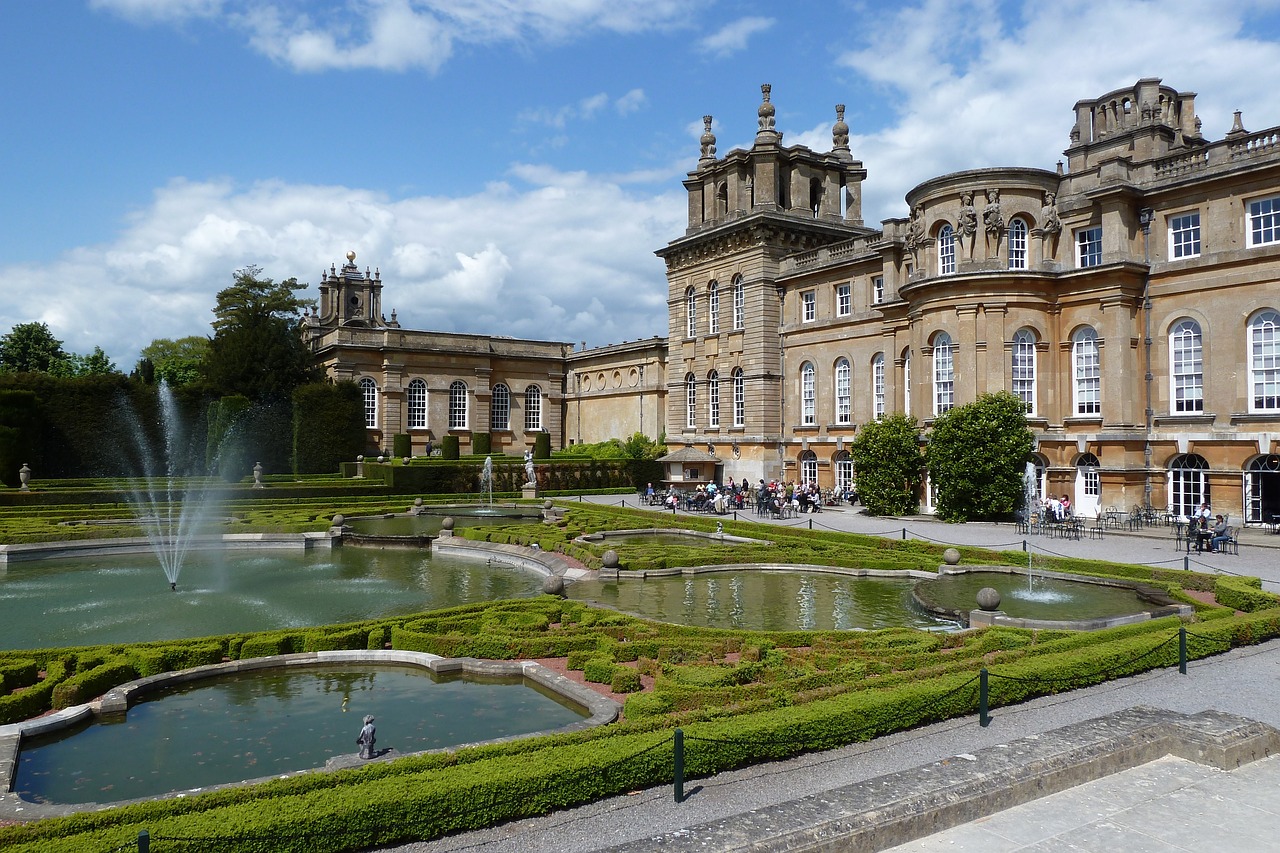
Blenheim Palace, located in Woodstock, Oxfordshire, is one of the most iconic stately homes in the United Kingdom. It is a masterpiece of Baroque architecture and is renowned for its stunning grounds and rich history. Built in the early 18th century, Blenheim Palace has been the ancestral home of the Churchill family for over 300 years. It is a UNESCO World Heritage Site and attracts thousands of visitors each year.
Blenheim Palace holds great importance in British history and culture. It was built as a gift to John Churchill, the 1st Duke of Marlborough, by Queen Anne for his victory at the Battle of Blenheim in 1704. The palace has since been passed down through generations of the Churchill family and has played a significant role in shaping British politics and society. It is also closely associated with Sir Winston Churchill, one of Britain’s greatest leaders, who was born at Blenheim Palace in 1874.
Summary
- Blenheim Palace is a stunning example of British architecture, located in Oxfordshire.
- The palace has a rich history, having been built as a gift to the first Duke of Marlborough in the early 18th century.
- The palace’s baroque architecture is a sight to behold, with intricate details and grandeur throughout.
- The grounds of Blenheim Palace are equally impressive, with a picturesque landscape and beautiful gardens.
- Visitors can explore the state rooms of the palace, which are filled with opulence and elegance, as well as a Churchill exhibition.
The History of Blenheim Palace: A Legacy of the Churchill Family
The history of Blenheim Palace is deeply intertwined with that of the Churchill family. John Churchill, the 1st Duke of Marlborough, was given the estate by Queen Anne as a reward for his military successes. Construction on the palace began in 1705 and took over 20 years to complete. The design was inspired by the Palace of Versailles in France and was intended to be a symbol of British power and prestige.
Over the years, Blenheim Palace has witnessed many significant events. During World War I, it served as a convalescent hospital for wounded soldiers. In World War II, it was used as a storage facility for priceless works of art from London’s museums to protect them from bombing raids. The palace has also hosted numerous political gatherings and state visits, including meetings between British Prime Ministers and foreign dignitaries.
The Architecture of Blenheim Palace: Baroque Style at its Finest
Blenheim Palace is a prime example of Baroque architecture, which was popular in Europe during the 17th and 18th centuries. This architectural style is characterized by grandeur, opulence, and intricate detailing. The palace features a symmetrical layout, with a central block flanked by two wings. The façade is adorned with ornate carvings, sculptures, and columns.
One of the most notable features of Blenheim Palace’s architecture is the Great Hall, which is considered one of the finest examples of Baroque design in Britain. It features a double-height ceiling, intricate plasterwork, and a grand staircase. The Long Library is another highlight, with its impressive collection of books and stunning views of the gardens.
Blenheim Palace’s architecture holds great significance in British architectural history. It was one of the first major buildings in England to incorporate Baroque elements and had a significant influence on subsequent architectural styles. The palace’s design and grandeur have inspired countless other buildings in the country.
Exploring the Grounds of Blenheim Palace: A Picturesque Landscape
| Metrics | Data |
|---|---|
| Size of Blenheim Palace Grounds | 2,100 acres |
| Number of Gardens | 9 |
| Length of the Grand Cascade Waterfall | 134 meters |
| Number of Statues and Sculptures | 30+ |
| Number of Lakes and Ponds | 2 lakes and 4 ponds |
| Length of the Vanbrugh Bridge | 110 meters |
| Number of Trees | over 30,000 |
| Number of Walking Trails | 6 |
The grounds of Blenheim Palace are as impressive as the palace itself. Designed by renowned landscape architect Capability Brown in the 18th century, they cover over 2,000 acres and feature a mix of formal gardens, woodland areas, and lakes. The landscape is meticulously maintained and offers visitors a picturesque setting to explore.
One of the key features of the grounds is the Grand Bridge, which spans across the lake and provides stunning views of the palace. The Water Terraces are another highlight, with their cascading fountains and manicured lawns. Visitors can also take leisurely walks through the woodland areas or enjoy a picnic by the lake.
There are plenty of activities to do in the grounds of Blenheim Palace. Visitors can take guided tours, rent bicycles to explore the extensive parkland, or even go on a boat ride on the lake. The grounds also host various events throughout the year, including outdoor concerts, garden festivals, and sporting events.
The State Rooms of Blenheim Palace: A Display of Opulence and Elegance
The state rooms of Blenheim Palace are a sight to behold. They showcase the opulence and elegance of the palace’s interiors, with their lavish furnishings, intricate tapestries, and priceless artworks. The state rooms are open to the public and offer a glimpse into the lives of the Churchill family.
The State Dining Room is one of the most impressive rooms in the palace. It features a long dining table that can seat up to 60 guests and is adorned with exquisite silverware and china. The Green Writing Room is another highlight, with its beautiful wallpaper and collection of family portraits.
The state rooms also house a remarkable collection of artworks, including paintings by renowned artists such as Sir Joshua Reynolds and Thomas Gainsborough. Visitors can admire these masterpieces as they wander through the rooms, gaining insight into the cultural and artistic heritage of Blenheim Palace.
The Churchill Exhibition: A Tribute to One of Britain’s Greatest Leaders
The Churchill Exhibition at Blenheim Palace is a tribute to Sir Winston Churchill, one of Britain’s most revered leaders. The exhibition showcases his life and legacy through displays and artifacts, providing visitors with a deeper understanding of his contributions to British history.
The exhibition features a collection of personal items belonging to Churchill, including his famous cigar collection, letters, and photographs. There are also interactive displays that allow visitors to learn more about his political career and his role in World War
Sir Winston Churchill was born at Blenheim Palace in 1874 and spent much of his childhood there. He later returned to the palace as an adult and held many important meetings and gatherings there. The Churchill Exhibition pays homage to his connection to Blenheim Palace and his lasting impact on British society.
The Park and Gardens of Blenheim Palace: A Haven for Nature Lovers
The park and gardens of Blenheim Palace offer a haven for nature lovers. The parkland covers over 2,000 acres and is home to a diverse range of flora and fauna. Visitors can explore the extensive grounds, take leisurely walks, or simply relax and enjoy the beauty of nature.
The gardens at Blenheim Palace are meticulously maintained and feature a variety of plants, flowers, and trees. The Rose Garden is a popular spot, with its vibrant blooms and intoxicating scents. The Secret Garden is another highlight, with its secluded pathways and hidden corners.
There are plenty of activities to do in the park and gardens. Visitors can go on guided tours to learn more about the flora and fauna, take part in nature walks, or even try their hand at fishing in the lake. The park also hosts various outdoor events throughout the year, including garden festivals and wildlife exhibitions.
Dining at Blenheim Palace: A Taste of British Cuisine in a Regal Setting
Dining at Blenheim Palace is a truly regal experience. There are several dining options available, ranging from casual cafes to elegant restaurants. Visitors can enjoy a taste of British cuisine while surrounded by the grandeur of the palace.
The Orangery Restaurant is one of the most popular dining venues at Blenheim Palace. It offers a range of dishes made with locally sourced ingredients, including traditional British classics with a modern twist. The restaurant also boasts stunning views of the gardens, making it the perfect setting for a memorable meal.
For those looking for a more casual dining experience, there are several cafes and tearooms scattered throughout the palace grounds. These offer a selection of light bites, sandwiches, cakes, and beverages, allowing visitors to take a break and refuel during their visit.
Events and Activities at Blenheim Palace: A Year-Round Programme of Entertainment
Blenheim Palace offers a year-round programme of events and activities for visitors of all ages. From outdoor concerts to family-friendly workshops, there is always something happening at the palace.
One of the highlights of the events calendar is the Blenheim Palace Festival of Literature, Film, and Music. This annual event brings together renowned authors, filmmakers, and musicians for a series of talks, screenings, and performances. It is a celebration of culture and creativity that attracts visitors from all over the world.
Other events at Blenheim Palace include garden festivals, sporting events, and historical reenactments. There are also regular workshops and activities for children, including arts and crafts sessions and nature walks. The palace’s events programme ensures that there is something for everyone to enjoy throughout the year.
Blenheim Palace also plays an important role in the local community. It provides employment opportunities for local residents and supports local businesses through partnerships and collaborations. The palace’s events and activities attract tourists to the area, boosting the local economy and promoting tourism in Oxfordshire.
Visiting Blenheim Palace: Tips for a Memorable Experience at this Iconic Stately Home
Planning a visit to Blenheim Palace? Here are some tips to help you make the most of your experience:
1. Plan ahead: Blenheim Palace can get busy, especially during peak tourist seasons. It is advisable to book your tickets in advance to avoid long queues and ensure entry on your preferred date.
2. Allow plenty of time: There is so much to see and do at Blenheim Palace that it is worth allocating a full day for your visit. This will give you ample time to explore the palace, grounds, and exhibitions at a leisurely pace.
3. Wear comfortable shoes: The grounds of Blenheim Palace are extensive, and there is a lot of walking involved. Make sure to wear comfortable shoes and dress appropriately for the weather.
4. Take a guided tour: To gain a deeper understanding of the history and significance of Blenheim Palace, consider taking a guided tour. There are several options available, including audio guides and private tours.
5. Check the events calendar: Before your visit, check the events calendar on the Blenheim Palace website. There may be special events or exhibitions happening during your visit that you don’t want to miss.
6. Bring a picnic: Blenheim Palace has plenty of picnic spots, so why not pack a picnic and enjoy a leisurely lunch in the beautiful surroundings? There are also several cafes and restaurants on-site if you prefer to dine indoors.
7. Don’t forget your camera: Blenheim Palace is incredibly photogenic, so make sure to bring your camera or smartphone to capture the stunning architecture and landscapes.
8. Take your time: Blenheim Palace is not a place to rush through. Take your time to soak in the beauty and history of this iconic stately home. Pause to admire the intricate details, read the information plaques, and fully immerse yourself in the experience.
Visiting Blenheim Palace is a truly memorable experience. From its stunning architecture to its picturesque grounds, there is something for everyone to enjoy. Whether you are a history buff, an art lover, or simply someone who appreciates natural beauty, Blenheim Palace is sure to leave a lasting impression.
FAQs
What is Blenheim Palace?
Blenheim Palace is a UNESCO World Heritage Site located in Woodstock, Oxfordshire, England. It is a country house that was built in the early 18th century and is the principal residence of the Dukes of Marlborough.
Who built Blenheim Palace?
Blenheim Palace was built by Sir John Vanbrugh and Nicholas Hawksmoor for John Churchill, the 1st Duke of Marlborough, as a gift from Queen Anne for his victory at the Battle of Blenheim in 1704.
What is the history of Blenheim Palace?
Blenheim Palace was built in the early 18th century as a gift from Queen Anne to John Churchill, the 1st Duke of Marlborough, for his victory at the Battle of Blenheim in 1704. It has been the principal residence of the Dukes of Marlborough ever since. During World War I, the palace was used as a hospital for wounded soldiers, and during World War II, it was used as a storage facility for works of art from the National Portrait Gallery and the Tate Gallery.
What are the features of Blenheim Palace?
Blenheim Palace is known for its Baroque architecture, extensive gardens, and parkland. It has over 2000 acres of landscaped gardens, including the Water Terraces, the Italian Garden, and the Rose Garden. The palace also has a collection of paintings, tapestries, and furniture, as well as a chapel and a library.
Is Blenheim Palace open to the public?
Yes, Blenheim Palace is open to the public. Visitors can explore the palace, gardens, and parkland, as well as attend events and exhibitions. There are also guided tours available.
What events are held at Blenheim Palace?
Blenheim Palace hosts a variety of events throughout the year, including concerts, food festivals, and Christmas markets. It also hosts exhibitions, such as the Winston Churchill exhibition, which explores the life and legacy of the former British Prime Minister.
Is Blenheim Palace accessible for disabled visitors?
Yes, Blenheim Palace is accessible for disabled visitors. There are disabled parking spaces, wheelchair access to the palace and gardens, and disabled toilets. There are also mobility scooters available for hire.



